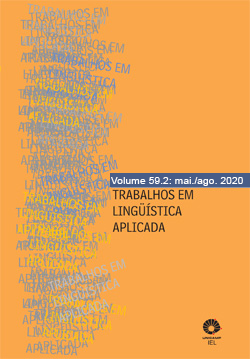Resumo
Essa contribuição visa fornecer tópicos úteis para entender a eficácia cognitiva dos gestos no ensino de línguas. Saindo da influência dos gestos em processos cognitivos, como alertar processos, memória, resolução de problemas e raciocínio, passaremos a mostrar as funções que os gestos podem desempenhar na educação linguística. O objetivo é destacar a necessidade de os professores L2 se conscientizarem cada vez mais do uso estratégico dos gestos no ensino.
Referências
ALIBALI, M.W., DIRUSSO, A.A. (1999). The function of gesture in learning to count: More than keeping track. Cognitive Development. v. 14, pp. 37-56.
ALIBALI, M. W., KITA, S., YOUNG, A. J. (2000). Gesture and the Process of Speech Production: We Think, Therefore We Gesture. Language and Cognitive Process. v. 15, n. 6, pp. 593-613.
BALBONI, P. E. (2015). Le sfide di Babele. Insegnare le lingue nelle società complesse. Milano: Utet, 4a Ed. 2020.
DIADORI, P. (2013). Gestualità e didattica della lingua straniera: questioni interculturali. In: Borello P., Luise M.C. (a cura di), Aspetti comunicativi e interculturali nell’insegnamento delle lingue. Alessandria: Edizioni dell’Orso. Disponibile online: http://www.siena-art.com/diadori/Testi/08iGESTI.pdf.
CLARK, H. (1996). Using Language. Cambridge: Cambridge University Press.
Ekman, P., Friesen, W. V. (1969). The repertoire of nonverbal behavior: Categories, origins, usage, and coding. Semiotica. n. 1, pp. 49-98.
GOLDIN-MEADOW, S. (2003). Hearing Gesture: How Our Hands Help Us to Think Cambridge (Massachusetts): The Belknap Press of Harvard University Press.
GOLDIN-MEADOW, S. (2004). Gesture’s Role in the Learning Process. Theory into Practice, v. 43, n. 4, pp. 314-321.
GRAZIANO, M., GULLBERG, M. (2013). Gesture production and speech fluency in competent speakers and language learners. In: Proceedings of the Tilburg Gesture Research Meeting (TiGeR). Tilburg: Tilburg University.
IANÌ, F., FORMICHELLA, M. (2017). Il ruolo cognitivo dei gesti. Giornale Italiano di Psicologia. n. 4, pp. 849-876. Disponibile online: https://iris.unito.it/handle/2318/1659812.
KENDON, A. (2004). Gesture. Visible action as utterance. Cambridge: Cambridge University Press.
KITA, S. (2000). How representational gestures help speaking. In: McNeill D. (Ed.), Language and gesture: Window into thought and action, Cambridge, UK: Cambridge University Press pp. 162-185.
KRAUSS, R.M. (1998). Why do we gesture when we speak? Current Directionsin Psychological Science. v. 7, pp. 54-60.
KRAUSS, R. M. et al. (2000). Lexical gestures and lexical access: A process model. In: McNeill D. (Ed.), Language and gesture. Cambridge: Cambridge University Press, Cambridge, pp. 162-185.
LAKOFF, G., JOHNSON, L. (1980). Metaphors We Live by, Chicago: Chicago University Press. Trad. Metafora e vita quotidiana. Milano: Bompiani, 1998.
MCNEILL, D. (1992). Hand and Mind. What Gestures Reveal about Thought. Chicago (Illinois): University of Chicago Press.
MCNEILL, D. (1998). Speech and gesture integration. In: Iverson, J. M., Goldin-Meadow, S. (Eds.). The nature and functions of gesture in children’s communication. San Francisco: Jossey-Bass, pp. 11-27.
MCNEILL, D. (Ed.) (2000). Language and gesture: Window into thought and action. Cambridge, UK: Cambridge University Press.
PAIVIO, A. (1969). Mental imagery in associative learning and memory. Psychological Review. v. 76, n. 3, pp. 241-263.
PAIVIO, A., DESROCHERS, A. (1980). A dual-coding approach to bilingual memory. Canadian Journal of Psychology. v. 34, pp. 390-401.
TALEGHANI-NIKAZM, C. (2008). Gestures in Foreign Language Classroom: An Empirical Analysis of their Organization and Function. In: Bowles, M. (Ed.). Selected Proceedings of the 2007 Second Language Research Forum. Somerville, MA: Cascadilla Proceeding Project, pp. 229-238.
TELLIER, M. (2006). L’impact du geste pédagogique sur l’enseignement-apprentissage des langues étrangères: Étude sur des enfants de 5 ans. Tesi di dottorato non pubblicata. Université Paris 7 – Denis Diderot, Paris.
TELLIER, M. (2008). The Effect of Gestures on Second Language Memorisation by Young Children. Gesture. v. 8, n. 2, pp. 219-235.
TOMASELLO, M. (1995). Joint attention as social cognition. In: Dunham, P. Moore, C. (Eds.), Joint attention. Its Origins and Role in Development. Hillsdale, NJ: LEA, pp. 103-129.
TOMASELLO, M. (2008). Origins of Human Communication, Massachusetts Institute of Technology. Trad. Le origini della comunicazione umana. Milano: Raffaello Cortina Editore, 2009.
TUMMILLO, F. (2016). Gestualità e didattica L2: spunti teorici e piste di lavoro. Lend. n. 2, pp. 122-130.
WILLEMS, R. et al. (2007). When language meets action: The neural integration of gesture and speech. Cerebral Cortex. v. 17, pp. 2322-33.
O periódico Trabalhos em Linguística Aplicada utiliza a licença do Creative Commons (CC), preservando assim, a integridade dos artigos em ambiente de acesso aberto, em que:
- A publicação se reserva o direito de efetuar, nos originais, alterações de ordem normativa, ortográfica e gramatical, com vistas a manter o padrão culto da língua, respeitando, porém, o estilo dos autores;
- Os originais não serão devolvidos aos autores;
- Os autores mantêm os direitos totais sobre seus trabalhos publicados na Trabalhos de Linguística Aplicada, ficando sua reimpressão total ou parcial, depósito ou republicação sujeita à indicação de primeira publicação na revista, por meio da licença CC-BY;
- Deve ser consignada a fonte de publicação original;
- As opiniões emitidas pelos autores dos artigos são de sua exclusiva responsabilidade.


